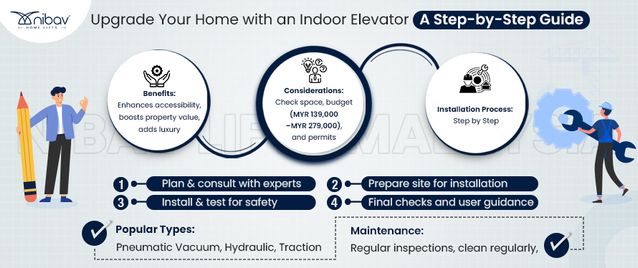Indoor home elevators are an advanced convenience that provides both accessibility and style to homeowners. Their capacity to increase both mobility and property value contributes to their rising popularity. Those individuals who have issues with using stairs due to age or disability will benefit from using these elevators.
In addition, they possess the authority to take even the simplest room and make it look luxurious. This guide covers all the bases: installation method, elevator types, pricing, and maintenance suggestions. It’s perfect for anybody thinking about installing an elevator for practicality, aesthetics, or future-proofing their property.
Benefits of Installing an Indoor Home Elevator
Several benefits might be yours with the installation of an indoor home elevator. It promotes accessibility, making multi-story living more practical for everyone, especially for persons with mobility issues. It also boosts property value, making it a sensible investment for future sales.
Beyond functionality, house elevators give a sense of luxury and modernism to your home’s decor. Modern designs are energy-efficient and adjustable, ensuring that the elevator merges naturally with your home’s decor while lowering energy use.

Key Considerations Before Installing an Indoor Home Elevator
Before beginning the process of installation, there are essential factors to consider:
1. Space Requirements and Structural Feasibility
Ensure there is appropriate room for the elevator shaft and the system. A complete structural evaluation of your home is necessary to determine that it can sustain the installation.
Some elevators, like pneumatic vacuum types, require limited structural alterations, while others may need considerable modifications. Planning early helps prevent unexpected problems and assists speed the installation process.
2. Budget and Financing Options
Evaluate the whole elevator price, including installation, modification, and upkeep. Additionally, consider future expenses like energy use and maintenance expenses to plan successfully within your budget.
Step-by-Step Process of Installing an Indoor Home Elevator
Here is a detailed guide to the installation process:
1. Planning and Consultation
Consult with a qualified elevators company to examine your needs, tastes, and home’s structural needs. This step includes examining elevator types, design preferences, and financial limits to produce a thorough strategy.
2. Choosing the Right Elevator Type
Select a good elevator type, considering variables such as available space, money, and aesthetic appeal. Common alternatives include pneumatic vacuum elevators for pleasant rides and traction elevators for energy economy. Your pick should fit with your mobility demands, design choices, and long-term ambitions.
3. Preparing the Installation Site
Clear the allotted space and verify it fulfills all necessary safety and construction requirements. Preparatory work may involve dismantling old buildings, strengthening flooring, or providing electrical connections. Proper site preparation provides a safe and fast installation procedure, avoiding any delays.
4. Installation and Final Checks
Experts will install the elevator, ensuring every part is appropriately installed and functional. After installation, thorough testing is undertaken to assure safety compliance and smooth functioning.
This step frequently involves guiding homeowners on running and maintaining the system. A final examination ensures everything satisfies safety regulations before the elevator becomes operational.
Top Indoor Home Elevator Types for Modern Homes
Researching the different types of house elevators might help you make a smart choice:
1. Pneumatic Vacuum Elevators
These compact elevators function using air pressure and are excellent for compact dwellings. Their sleek form and simple setup requirements serve as an ideal option for modern environments. Additionally, its economical operation and panoramic view design provide both usefulness and aesthetic value. These elevators are noted for their accuracy and endurance, making them a popular choice for multi-story residences.
2. Hydraulic Elevators
These types of elevators are also smooth-running and provide long service. It is operated using a hydraulic cylinder. They are appropriate for homes with higher levels of flexibility and can tolerate larger weight capabilities. Hydraulic systems are also quieter, giving a smooth experience for regular usage without interrupting home activities.
3. Traction Elevators
Traction elevators employ ropes and a balancing mechanism, allowing efficient and silent operation. They are a terrific solution for those searching for an eco-friendly and reliable system that combines easily with current designs.
Cost Breakdown of Installing an Indoor Home Elevator
The fee level of home elevator installation depends on the kind of solution, possibilities of individual equipment, and work required. Usually, homeowners spend about MYR 139000 to MYR 279000. There are always additional costs that may relate to construction, permits, or technological improvements such as the use of smart controls.
Customizations such as special finishes, lighting, and enhanced safety measures can further add to the overall elevator’s price. Request accurate estimates from your preferred home elevators company to prepare properly and minimize unforeseen charges. Regularly evaluating and adjusting the finances during the budgeting process might assist in accommodating any changes.
How to Choose the Right Installation Partner
Selecting a trustworthy installation partner is important for a successful project. Look for a Nibav provider with vast expertise, great client evaluations, and comprehensive offerings. Ensure the provider offers post-installation maintenance and assistance.
A trustworthy partner will also give upfront pricing, specific timetables, and skilled advice throughout the whole installation process. Checking for credentials and industry connections can further prove their competence and dedication to quality.
Maintenance Tips for Long-Lasting Indoor Home Elevators
Regular maintenance maintains the reliability and secure operation of your indoor home elevator. Follow these tips:
- Schedule regular checks and services with specialists to identify and handle any concerns early.
- Keep the elevator neat and free from dirt to prevent operating impediments.
- Address any strange sounds or operating delays soon to avoid significant repairs.
- Follow the manufacturer’s directions for best use and maintenance, including suggested cleaning chemicals and usage limitations.
- Invest in a maintenance agreement with your installation firm for ongoing care and assistance. Staying proactive with maintenance may extend the life of your elevator and decrease repair expenses.
Conclusion
Installing an indoor home elevator could revolutionize your living area, bringing ease, accessibility, and style. By knowing the installation procedure, pricing, and maintenance requirements, you can make an informed selection that corresponds with your demands and budget.
With the correct design and expert guidance, your home elevator will be a valued addition that increases your quality of life for years. Investing in this contemporary feature guarantees your house stays practical and appealing for present and future requirements.
FAQ’s
1. What are the benefits of installing an indoor home elevator?
Indoor home elevators increase accessibility, raise property value, and offer a magnificent touch to your home. They also offer convenience for senior family members or persons with mobility issues, ensuring that all sections of your house are easily approachable.
2. How much does it cost to install an indoor home elevator?
The total elevator cost varies between MYR 139000 to MYR 279000, which depends upon the kind, choice, and installation process. Other expenses may include licenses, structural adjustments, and maintenance of different parts.
3. Can I install an indoor home elevator in a small house?
Yes, compact solutions like Nibav pneumatic vacuum elevators are acceptable for small houses. These versions require little structural adjustments and fit neatly into tight locations. Consulting with a specialist may help you identify the optimum elevator type for your unique layout and space limits.
4. What are the safety requirements for an indoor home elevator?
Safety standards include correct installation, frequent maintenance, and accordance with building rules and manufacturer specifications. Additional safety measures, such as emergency stop buttons, backup power systems, and interlocking doors, strengthen the elevator’s reliability and safeguard users in case of unforeseen complications.




